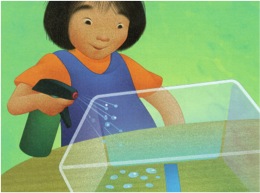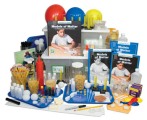Archive for May, 2013
Introduce Students to Concepts About Shorelines and Beaches
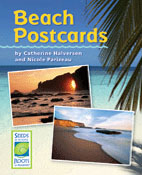 Most students have heard the terms “beach” and “shoreline,” but do they know the difference?
Most students have heard the terms “beach” and “shoreline,” but do they know the difference?
Here are some important concepts for students:
- a shoreline is a place where water meets land
- a beach is a shoreline where people can walk near the water
- beaches are covered with loose material
- beaches can be rocky, sandy, or covered with coral or beach wrack
In the Seeds of Science/Roots of Reading® book Beach Postcards, students can read an account of a girl named Jo, who visits beaches around the world with her family, and sends postcards back to her friend Linn. Linn writes a report about what she learned about beaches and shorelines from Jo’s postcard. In addition to conveying the concepts bulleted above, the book is also designed to help students who may have limited knowledge of shorelines to imagine the experience of being at various beaches.
Below are some questions you can pose using content taken from the book.
How is a beach different from some kinds of shorelines?
Explain that the place where water meets the land is called a shoreline. There are many kinds of shorelines all around the world.
Beaches are one kind of shoreline. Beaches are shorelines where people can walk beside the water. Beaches are covered with loose material like rocks or sand. Beaches can form along lakes, rivers, and the ocean.
What do you think you would see if you were standing on a rocky beach? What would you feel? What would you wear to visit this beach?
Explain that rocky beaches are covered with rocks and pebbles. Some of the rocks are big. The pebbles are small.
Rocks and pebbles get to the beach in many ways. Rocks can fall onto the beach from cliffs. Rocks on the beach can break and become pebbles. Rocks and pebbles can be carried to the beach by waves or rivers. There may be (more…)
Help Students Model the Process of an Investigation
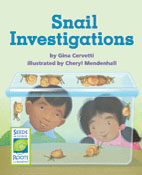 Students can follow the same steps a scientist takes during an investigation. An investigation is considered to be any formal effort to inquire about something. Investigations include all of the various ways that scientists find out about the world: experiments; systematic observations; making and testing a model; summarizing what others have learned from research papers, articles, or books; etc. People often misrepresent the ways that scientists investigate by calling everything a scientists does an experiment. Actually, an experiment is a very specific kind of investigation, involving a comparison between two situations that are alike in all ways but one.
Students can follow the same steps a scientist takes during an investigation. An investigation is considered to be any formal effort to inquire about something. Investigations include all of the various ways that scientists find out about the world: experiments; systematic observations; making and testing a model; summarizing what others have learned from research papers, articles, or books; etc. People often misrepresent the ways that scientists investigate by calling everything a scientists does an experiment. Actually, an experiment is a very specific kind of investigation, involving a comparison between two situations that are alike in all ways but one.
In the Seeds of Science/Roots of Reading® student book Snail Investigations, a story models the process of conducting an investigation – ask a question, investigate, record observations, make an explanation based on evidence, and ask a new question. Below is a sample section from the book to show how a student conducts an investigation with snails. You can share this with your students, discuss the investigation process and problems encountered by the student in the book. Make note of bolded words which can be highlighted as important science vocabulary terms.
Students learn:
- it is possible to investigate to find answers to questions
- scientific investigations involve a series of steps
- scientists often encounter unexpected problems as they investigate and have to think of new ways to answer questions
- it is important to make a careful record of one’s observations, and there are many different ways to do so
Investigating what makes a good snail habitat.
How much moisture do snails need?
Hope’s question was, “How much moisture do snails need in their habitat?” She wondered whether a wet or dry habitat is better for snails.
Hope sprayed a little water on half of her terrarium floor. That half of the floor became very moist. She was careful to keep the other half of the floor dry.
Hope put seven snails in a line on the terrarium floor, between the wet half and the dry half. She got out her notebook to record where they went.
Hope observed her snails’ behavior. Six snails climbed to the terrarium lid. The seventh snail didn’t move at all.
Hope was not sure what to think. She expected the snails to choose either the wet half or the dry half of the terrarium floor. But most did not choose either one. They climbed to the lid instead. She did not have enough evidence to answer her question. How could she find out how much moisture snails need? She wondered if climbing up is just what snails do.
Next Hope read a book about snails. She learned that snails do often climb on rocks, twigs, and walls. Hope decided to observe more snails. She placed 22 snails in a dry, empty terrarium. When Hope checked an hour later, she found only two snails ob the bottom. Ten snails were on the sides and ten were on the top.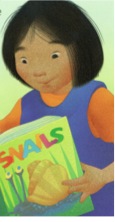
Hope still did not know which is better for snails, a wet habitat or a dry habitat. But she did find out something about how snails behave.
Hope knew she would need to find a different way to investigate her question, “How much moisture do snails need?”
At this point, you can ask your students how they would investigate Hope’s question. To record their investigation, they could create a table that allows them to make note of each step’s results.
Step 1: Ask a question
Step 2: Investigate
Step 3: Record observation
Step 4: Make an explanation based on evidence
Step 5: Ask a new question
To reinforce the process, have the students retell what happened in Hope’s investigation and fill out the table as if it were their investigation.
Reinforce concept of what it means to investigate
Ask, “What have we learned about what it means to investigate?” Accept several responses. Tell students that investigating is an important part of what scientists do, so it’s important that we really understand what it means to investigate. Read the following sentences: “There are many ways to investigate your question. You can observe. You can read. You can ask an expert.”
Ask, “What does investigate mean?” Accept several responses. Tell students that investigate means to search for evidence to try to learn more about something. Usually when we investigate, we follow a series of steps to try and answer a question. When scientists want to answer questions about the world, they investigate. Scientists investigate many things, including how to cure diseases, how to help plants grow, and what animals live in the rain forest.
For more information about the student book Snail Investigations and the Soil Habitats science and literacy unit, visit http://www.scienceandliteracy.org.
Do you want to be notified when we publish new blog articles? Simply enter your email address in the “Follow Blog via Email” box located in the right sidebar.
Earthworms Help Students Understand Habitat and Adaptation
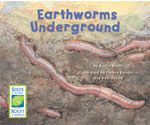 Earthworms have different structures and behaviors that help them survive in their underground habitat. These adaptations are intriguing to students who wonder things such as:
Earthworms have different structures and behaviors that help them survive in their underground habitat. These adaptations are intriguing to students who wonder things such as:
- How do earthworms breathe underground?
- How do earthworms move around?
- What do earthworms eat?
- How do earthworms protect themselves from danger?
These questions are answered in the Seeds of Science/Roots of Reading® book Earthworms Underground. You’ll find the details below. In addition, we’ve suggested an activity that will help reinforce key concepts you’ve presented to your students.
How do earthworms breathe underground?
When people breathe, you see their bellies moving in and out. You won’t see that in an earthworm. To breathe, an earthworm absorbs air through its skin. An animal that breathes through its skin needs moisture. If the animal’s skin dries out, it can’t absorb air. An earthworm’s habitat is soil with lots of moisture. The earthworm can breathe there.
How do earthworms move around?
Many animals move with their legs. But earthworms don’t have legs! Legs would get in the way in earthworms’ tiny underground burrow. Earthworms have different adaptations for moving through the soil. Earthworm bodies are made of segments. Each segment has tiny hairs on it. View the illustration below to see how the segments and tiny hairs work with the movement process of earthworms.
What do earthworms eat?
Earthworms eat soil and the dead and living organisms in the soil. Sometimes you can see all this stuff moving through an earthworm’s body. Earthworms dig through the soil as they eat. The burrows they dig can last a long time. Earthworms use the burrows to get from place to place.
Because it eats dead organisms, an earthworm is called a decomposer. It breaks down dead things into soil. Sometimes when it’s wet and dark outside, earthworms go above ground. They find small dead organisms, like leaves and beetles, and pull them underground to eat.
How do earthworms protect themselves from danger?
Living underground protects earthworms from many predators, but not all of them. Some predators, like moles, live underground, too. Moles are small, furry animals with tiny eyes. Their front legs are shaped for digging. When a mole comes near, earthworms can feel the soil shaking. They move quickly to get away.
Birds are also predators of earthworms. Some birds stand on the ground and listen for earthworms moving under them. The birds try to pull earthworms out of their burrows. Earthworms hold on to the soil with their tiny hairs. Sometimes the bird eats the whole earthworm. But earthworms have a strange adaptation to protect themselves.
If a bird pulls on an earthworm’s tail end, sometimes it breaks off. The bird is left with just a piece of tail. The piece keeps moving, and the bird may think it has the whole earthworm. If only a little bit of the tail breaks off, the earthworm can move away and survive. Later, the tail grows back.
Reinforce concepts with pictorial representations
After you’ve used the information above to explain an earthworm’s habitat and adaptation to your students, have some volunteers make pictorial representations of the key concepts on a concept wall. Give each small group one of the key concepts and ask them to create a drawing to represent the concept. Tell them that, first, they will need to decide as a small group what they would like to draw. Then distribute drawing paper and crayons to each small group.
For more information about the student book Earthworms Underground and the Soil Habitats science and literacy unit, visit http://www.scienceandliteracy.org.
Do you want to be notified when we publish new blog articles? Simply enter your email address in the “Follow Blog via Email” box located in the right sidebar.

